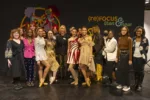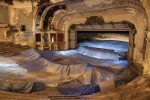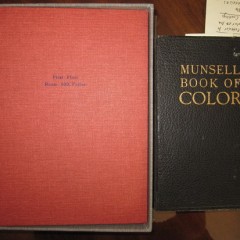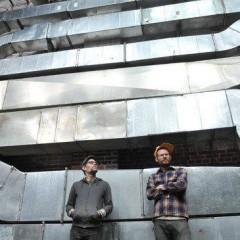From May 23rd to June 30th, Hidden City Philadelphia will hold its second Hidden City Festival, hosting art shows and events at nine sites around the Philadelphia area. Hidden City Philadelphia was born out of its previous festival, held in 2009. Now a successful full-time online magazine, Hidden City also hosts tours and events, and boasts a developing Community Action program. The idea of the Hidden City Festival is to mount contemporary, site-based art installations in little-known or endangered sites throughout Philadelphia, preferably with some kind of connection to the city’s heritage. For the 2013 festival, which features taglines like “Ready, Set, Explore,” and “See the City Anew,” Hidden City is hoping to offer Philadelphians the opportunity to explore unique environments, view intriguing and original art, and visit parts of the city that might otherwise escape their notice, all while engaging with Philadelphia’s rich and diverse history.
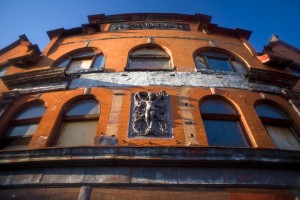
Rabid Hands Art Collective uses abandoned spaces and their unique histories as inspiration
I recently has the opportunity to visit Hawthorne Hall, one of the nine sites featured this year, for a preview showing. Hawthorne Hall, tucked inside an apartment block in Powelton, is home to a sprawling, walk-through installation piece created for the festival by Rabid Hands Art Collective.
As a group, Rabid Hands is primarily interested in overtaking abandoned or underused locations with epic installations pieces. To do this, they invite many artists with a wide range of artistic practices to come and engage with the site, co-creating installations in a deeply collaborative process. Rabid Hands creates work using discarded and found materials inside unique architectural spaces. The goal is to have the art and the space itself frame and comment upon one another in ways not possible in traditional gallery spaces.
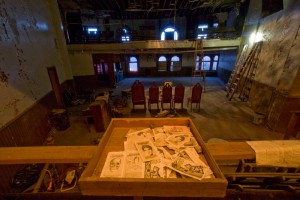
A major inspiration for Rabid Hands’ transformation of Hawthorne Hall is the rich history of the space. Built in 1895, the Hall has been home to dozens of organizations over the years. Notable groups that have inhabited – and thus altered, modified, and left their charge upon space – include the Irish National Foresters, New Light National Baptist Church, and the Knights of Pythias. Unique moldings suggest the space may have also been home to a cabaret theater at one point. Each of these former tenants added to the space, either physically altering it or imbuing it with new meaning by their presence and the rituals they enacted within it.
Rabid Hands is using this idea as a jumping-off point, hoping to emphasize these layers of history through their installations. To do this, the artists are forming The Society of Pythagoras, a secret society much like ones formerly housed in the Hall. Each of the artists will take on a specific role and title within the society, and the pieces they create will reflect and play off of the secretive, ritualistic practices these kinds of societies engage in.
Walking through the space, visitors will find themselves gradually initiated into the society as well, each setpiece serving as some unique kind of introduction or induction ceremony.
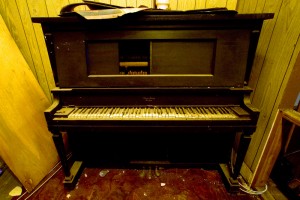
Rabid Hands’ installation engages and melds with Hawthorne Hall
The sprawling interior of Hawthorne Hall is an excellent example of wabi-sabi, an aesthetic concept originating in Japan that privileges the beauty of imperfection in nature and the inevitability of decay. Wabi-sabi places this more authentic aesthetic, with its many imperfections, over the manufactured or uniform. Hawthorne Hall is both beautiful and charged with history, in large part because it’s resplendent with swaths of rust, walls of chaotically textured chipping paint, expanses of crumbling wooden rafters, and stretches of cracked cement; we can see how time and use have weathered this space, leaving indelible marks and blemishes that are both imperfect and beautiful at once.
One of the most fascinating elements of Rabid Hands’ approach is the ways in which their art does not merely exist within the space but actually merges and melds with the existing architecture, becoming a part of the space in the process. An “Initiation Chamber,” a wooden structure built into the central room of the Hall, seems to spill out organically from the fragmented roof timbers above it. Visitors can descend down clanging metal steps into a massive, below-ground baptismal fount where they will find themselves submerged in light. A twisting, stone corridor will lead to reliquaries tucked behind crumbling wooden doors. A series of carefully constructed balconies hold arcane symbols in their rusted railings. Secret doors open to reveal hidden ceremonial chambers.
It seems that in every corner of Hawthorne Hall, Rabid Hands offers new ways to engage with the space and the many layers of history contained therein. In peeling back, exposing, and engaging with these layers and thereby emphasizing the charges that history can leave upon a place, the artists allow a visitor to interact and encounter this history in novel ways, and transform this neglected space into one suffused with meaning and possibility in the process.
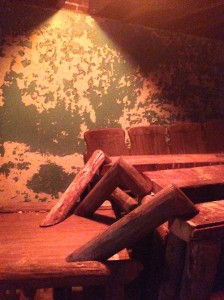
Rabid Hands’ work at Hawthorne Hall reflects Hidden City’s mission
The aim of the Hidden City Festival is to celebrate the power of place by offering up unique spaces for contemporary artists to transform. By allowing these artists to engage with forgotten fragments of Philadelphia’s past, the Festival hopes to inspire people to get engaged with history while simultaneously imagining new, potentially radical futures for city. By illuminating the beauty, power, and even practical use of obscure and forgotten urban spaces, new ways to interact with all corners of our urban landscape emerge. From what I saw of Hawthorne Hall and from the brief conversations I had with some of the artists involved, it seems that Rabid Hands is approaching this mission in a number of fascinating ways.
Rabid Hands wants us to experience art that engages all the senses, that is tactile, textural, and tells a story. They want to explore the positive ramifications of giving abandoned spaces new life, even if only temporarily. They want to encourage us to encounter spaces deemed “useless” and instead see new possibilities. They want us to find the beauty in dilapidation and thus come to see our constant demand for the new and the pristine as misguided. Their mission is a radical one, and fits in perfectly with Hidden City’s progressive conception of urban space.
Although very much a work-in-progress when I viewed the site earlier this month, Rabid Hands’ takeover promises to transform Hawthorne Hall into a fascinating exploration and re-contextualization of the history of that site and, by extension, our city.
The Hidden City Festival 2013 runs from May 23rd to June 30th. Festival passes, schedules of events, and Hidden City Membership information can be found here.



